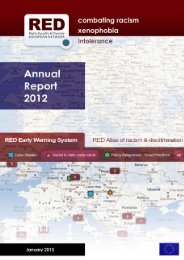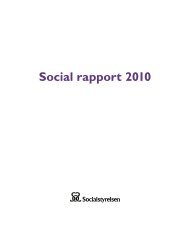R12PITFALLS AND BIASINTRODUCTIONThe overrepresentation <strong>of</strong> pupils from cultural <strong>and</strong> linguistic minority communities in special education is endemicworldwide, <strong>and</strong> children from <strong>Romani</strong> communities in Central <strong>and</strong> South Eastern Europe are subject to thissegregation <strong>and</strong> marginalization through <strong>the</strong>ir overwhelming placement in special education schools for pupilswith mental disabilities. The purpose <strong>of</strong> this study is to examine some <strong>of</strong> <strong>the</strong> ways in which <strong>Romani</strong> children from<strong>the</strong> Czech Republic, Hungary, Serbia, <strong>and</strong> <strong>the</strong> Slovak Republic are segregated from <strong>the</strong>ir non-<strong>Romani</strong> peers<strong>and</strong> placed in <strong>the</strong> special education system. This is done through school readiness assessment (colloquially, schoolentry testing 1 ), by which children are denied entry to school through a delay <strong>of</strong> school entry, streamed 2 intopreparatory or transition classes in special schools, or directly assessed with st<strong>and</strong>ardized psychological <strong>and</strong>/oreducational tests 3 for placement in special education classrooms or schools. This study reviews <strong>the</strong> issues associatedwith such testing, <strong>the</strong> links with <strong>the</strong> overrepresentation <strong>of</strong> <strong>Romani</strong> children in special education, <strong>and</strong> <strong>the</strong>relationships to secondary education <strong>and</strong> post-school employment opportunities. This study also examinesinternational good practice in <strong>the</strong> use <strong>of</strong> school readiness/entry assessments that are used to integrate <strong>and</strong>not segregate children <strong>and</strong> draws conclusions <strong>and</strong> sets out recommendations about how to address issues aroundschool readiness/entry assessments.SCHOOL READINESS ASSESSMENT AND ITS USESIn <strong>the</strong> countries discussed in <strong>the</strong> case studies <strong>of</strong> this paper, a child is typically considered to be ready to attendschool—ei<strong>the</strong>r kindergarten 4 or <strong>the</strong> first year <strong>of</strong> primary education—when he or she exhibits developmentalmaturity in social, cognitive, <strong>and</strong> physical abilities that will allow a child to be successful in school. Admittance tokindergarten or to <strong>the</strong> first year <strong>of</strong> compulsory primary schooling is usually connected in some way with anassessment <strong>of</strong> a child’s readiness for school <strong>and</strong> screening for special educational needs (SEN).1 School readiness, or school entry, testing is <strong>the</strong> assessment a child typically undergoes before <strong>the</strong> first year <strong>of</strong> compulsory schooling, duringwhich <strong>the</strong> child’s developmental maturity in <strong>the</strong> areas <strong>of</strong> physical /motor, social-emotional, language (for example, phonemic awareness,identifying letters), visual discrimination, <strong>and</strong> fine motor skills.2 “Streaming” is <strong>the</strong> tracking <strong>of</strong> pupils into homogeneous academic ability or interest groups. In <strong>the</strong> context <strong>of</strong> this study, streaming refersto <strong>the</strong> process <strong>of</strong> moving pupils from general education, out <strong>of</strong> <strong>the</strong> mainstream, into segregated transition, preparatory, or special educationsettings. This occurs through some form <strong>of</strong> assessment <strong>and</strong> subsequent determination <strong>of</strong> special educational needs.3 Psychological <strong>and</strong>/or educational assessments are norm-referenced, st<strong>and</strong>ardized instruments purportedly designed to provide estimates<strong>of</strong> an individual’s intellectual/cognitive abilities <strong>and</strong> educational achievement levels. An example <strong>of</strong> an assessment for intellectual ability is<strong>the</strong> Wechsler Intelligence Scale for Children, Fourth Edition (WISC-IV), while an assessment for educational achievement is <strong>the</strong>Woodcock-Johnson III Tests <strong>of</strong> Achievement.4 In this paper, “kindergarten” is used as a general term for preschool, or early childhood education, for children ages three to five or six. Insome countries, as will be noted, <strong>the</strong> last year <strong>of</strong> kindergarten is considered <strong>the</strong> first year <strong>of</strong> compulsory schooling, but in o<strong>the</strong>r countries,kindergarten is not compulsory.
R13School readiness assessment emerged from <strong>the</strong> rise <strong>of</strong> compulsory schooling several centuries ago. During <strong>the</strong>Reformation, Martin Lu<strong>the</strong>r first advocated for compulsory education in order for people to be able to read <strong>the</strong> Bible.In 1774, Empress Maria Theresa made primary education m<strong>and</strong>atory for children aged 6 to 12; similar laws wereimplemented throughout Europe at this time. The reasons for compulsory schooling, however, were not toensure that individuals would be able to read <strong>the</strong> Bible; ra<strong>the</strong>r, schooling was a nation-building mechanism throughwhich individuals in an empire’s territories were to be assimilated into obedient citizens via academic <strong>and</strong> moraleducation.During <strong>the</strong> nineteenth century in both Europe <strong>and</strong> <strong>the</strong> United States, in response to industrialization, early childhoodcare <strong>and</strong> education, including kindergarten, emerged so that working poor women could participate in <strong>the</strong> laborforce (Kamerman 2006, 12–13). In <strong>the</strong> United States in <strong>the</strong> nineteenth <strong>and</strong> early twentieth centuries, during atime <strong>of</strong> rapid industrialization <strong>and</strong> immigration, schooling was compulsory for children, but children might enterschool at any age. In 1908, American psychologist Edward Thorndyke conducted a national study <strong>of</strong> schoolefficiency through an examination <strong>of</strong> pupils’ grades, ages, <strong>and</strong> performance through which he determined thatonly one in ten pupils graduated from high school <strong>and</strong> that one-third graduated from primary school (Angus,Mirel, <strong>and</strong> Vinovskis 1988, 220–221).In various studies conducted in urban areas, many pupils who performed poorly in school were determined to haveintellectual disabilities through tests developed in <strong>the</strong> newly emerging field <strong>of</strong> educational psychology; incompeting paradigms <strong>of</strong> this new field, some considered such children to be curable through educational “treatment”(Angus et al. 1988, 222–223). It was also during this time that child labor laws began to be enforced, <strong>and</strong> one <strong>of</strong><strong>the</strong> ways to enforce this was to concurrently enforce compulsory school attendance. Poor achievement, highfailure rates <strong>of</strong> pupils, <strong>and</strong> overage pupils in schools were <strong>the</strong> impetus for <strong>the</strong> establishment <strong>of</strong> special educationclasses, IQ testing, tracking, <strong>and</strong> ability grouping in schools in order to teach pupils more efficiently (May <strong>and</strong>Campbell 1981, 130; Angus et al. 1988, 224). The Detroit, Michigan school district implemented <strong>the</strong> first documentedschool readiness assessment in 1920, when it began testing all first graders <strong>and</strong> <strong>the</strong>n tracked <strong>the</strong>m into classesfor differing abilities, including special education classes (Angus et al. 1988, 225). The purpose <strong>of</strong> kindergarten<strong>the</strong>n became to provide socio-educational experiences for young children <strong>and</strong> to ready <strong>the</strong>m for primary school(Kamerman 2006, 11).Questions about <strong>the</strong> best age for a child to begin compulsory education arose in <strong>the</strong> context <strong>of</strong> increasing attentionto school efficiency. Gesell’s <strong>the</strong>ory <strong>of</strong> maturation <strong>and</strong> child development largely influenced <strong>the</strong> determinationthat age six was <strong>the</strong> most appropriate age at which to commence compulsory schooling (Snow 2006, 9), but <strong>the</strong>various approaches to child development are mirrored by competing ideas about criteria <strong>and</strong> methods for measuringa child’s readiness for school. In a literature review <strong>of</strong> measuring school readiness, Snow (2006) identifies <strong>the</strong>competing frameworks. The maturationist developmental perspective is relatively static, based on <strong>the</strong> idea that
- Page 3 and 4: R3CONTENTSACKNOWLEDGMENTS 4EXECUTIV
- Page 5 and 6: R5EXECUTIVE SUMMARYThis policy pape
- Page 7: R7For Romani children in Central an
- Page 10 and 11: R10PITFALLS AND BIAS4. Discontinue
- Page 14 and 15: R14PITFALLS AND BIASa child is read
- Page 16 and 17: R16PITFALLS AND BIASthe child (Ryan
- Page 18 and 19: R18PITFALLS AND BIASTABLE 2. Placem
- Page 20 and 21: R20PITFALLS AND BIASAMONG THE ROOTS
- Page 22 and 23: R22PITFALLS AND BIASTAXONOMY OF “
- Page 24 and 25: R24PITFALLS AND BIASdevelop the ver
- Page 26 and 27: R26PITFALLS AND BIAS2008, 136). Ard
- Page 28 and 29: R28PITFALLS AND BIASBias in test ad
- Page 30 and 31: R30PITFALLS AND BIASWhile the test
- Page 32 and 33: R32PITFALLS AND BIASOF ROMANI CHILD
- Page 34 and 35: R34PITFALLS AND BIAStwo distinct ty
- Page 36 and 37: R36PITFALLS AND BIASPOLICY AND PRAC
- Page 38 and 39: R38PITFALLS AND BIASand had to repe
- Page 40 and 41: R40PITFALLS AND BIASOrientation Tes
- Page 42 and 43: R42PITFALLS AND BIASTABLE 5. Educat
- Page 44 and 45: R44PITFALLS AND BIASCOUNTRY-SPECIFI
- Page 46 and 47: R46PITFALLS AND BIASPLACEMENT IN SP
- Page 48 and 49: R48PITFALLS AND BIASCompulsory scho
- Page 50 and 51: R50PITFALLS AND BIASand Educational
- Page 52 and 53: R52PITFALLS AND BIAS121.1.cc.ii). A
- Page 54 and 55: R54PITFALLS AND BIASTest of School
- Page 56 and 57: R56PITFALLS AND BIASof the overall
- Page 58 and 59: R58PITFALLS AND BIASAS WITH OTHER C
- Page 60 and 61: R60PITFALLS AND BIASfirst grade, or
- Page 62 and 63:
R62PITFALLS AND BIASbases listed in
- Page 64 and 65:
R64PITFALLS AND BIASof Societies in
- Page 66 and 67:
R66PITFALLS AND BIASTABLE 13. Pupil
- Page 68 and 69:
R68PITFALLS AND BIASROMANI CHILDREN
- Page 70 and 71:
R70PITFALLS AND BIASdetermined to c
- Page 72 and 73:
R72PITFALLS AND BIASdeveloped in th
- Page 74 and 75:
R74PITFALLS AND BIASWechsler Intell
- Page 76 and 77:
R76PITFALLS AND BIAStheir chances t
- Page 78 and 79:
R78PITFALLS AND BIASREPRESENTATION
- Page 80 and 81:
R80PITFALLS AND BIASTABLE 20.Enroll
- Page 82 and 83:
R82PITFALLS AND BIAS
- Page 84 and 85:
R84PITFALLS AND BIASGOOD PRACTICE A
- Page 86 and 87:
R86PITFALLS AND BIASStudent assessm
- Page 88 and 89:
R88PITFALLS AND BIASThe United King
- Page 90 and 91:
R90PITFALLS AND BIASor assistance i
- Page 92 and 93:
R92PITFALLS AND BIASTeachers report
- Page 94 and 95:
R94PITFALLS AND BIASTHE DETERMINATI
- Page 96 and 97:
R96PITFALLS AND BIASintellectual di
- Page 98 and 99:
R98PITFALLS AND BIAS8. Ensure that
- Page 100 and 101:
R100PITFALLS AND BIASANNEX 1:RELIAB
- Page 102 and 103:
R102PITFALLS AND BIAS1. Does the te
- Page 104 and 105:
R104PITFALLS AND BIASANNEX 2:COMPON
- Page 106 and 107:
R106PITFALLS AND BIASFIGURE A4. Sam
- Page 108 and 109:
R108PITFALLS AND BIASAshton-Warner,
- Page 110 and 111:
R110PITFALLS AND BIASCahn, Claude,
- Page 112 and 113:
R112PITFALLS AND BIASD.H. and Other
- Page 114 and 115:
R114PITFALLS AND BIASFigueroa, Rich
- Page 116 and 117:
R116PITFALLS AND BIASGovernment of
- Page 118 and 119:
R118PITFALLS AND BIASHayman, Robert
- Page 120 and 121:
R120PITFALLS AND BIASKovács-Cerovi
- Page 122 and 123:
R122PITFALLS AND BIASMacura-Milovan
- Page 124 and 125:
R124PITFALLS AND BIASMoore, Tom. 20
- Page 126 and 127:
R126PITFALLS AND BIASRadivojevic, D
- Page 128 and 129:
R128PITFALLS AND BIASShepard, Lorri
- Page 130 and 131:
R130PITFALLS AND BIASTomatová, Jan
- Page 132 and 133:
R132PITFALLS AND BIASVláda Česká
- Page 134:
Copyright © 2012 Roma Education Fu




